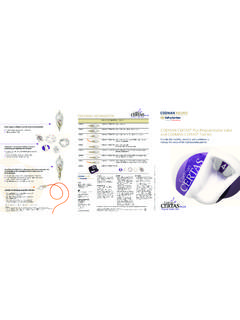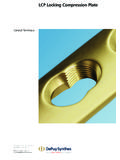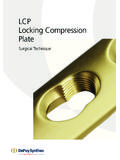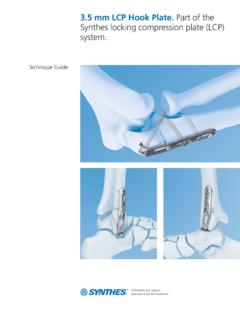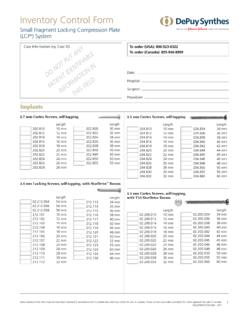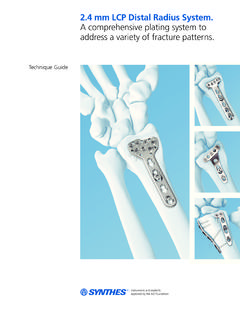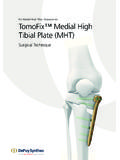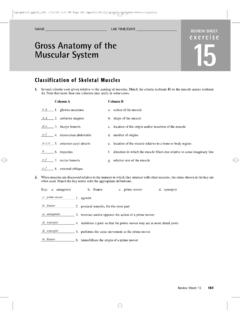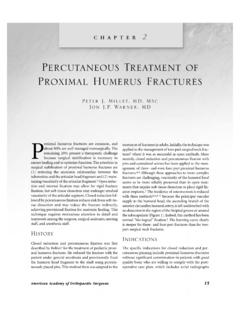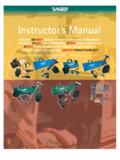Transcription of SurgIcal technIque - Limelight Networks
1 SurgIcal technIqueFor intramedullary fi xation of proximal femoral fracturesImage intensifier controlTFN AdvANced proximal Femoral Nailing System (TFNA) SurgIcal technIque dePuy Synthes companiesIntroductIon SurgIcal technIqueProduct InformatIontable of contentSclinical cases 2 ao Principles 4 Indications and Precautions 5 Preparation 6open proximal femur 10 Insert nail 16 proximal locking 19 distal locking Short nails 37 freehand distal locking long nails 40 Insert end cap 45 Implant removal 46 checking drill Stop Wear 51 Implants 52 Instruments 59 Set lists 682 dePuy Synthes companies TFN AdvANced proximal Femoral Nailing System (TFNA) SurgIcal TechniqueclInIcal caSeStfn advancedtm proximal femoral naIlIng SyStem (tfna)Case 1 *x 72-year-old femalex fracture ao 31a3 fracture (transverse intertrochanteric fracture pattern) which is unstable and would benefit from a cephalomedullary device.
2 A short or a long nail would be sufficient in this case. a long nail was chosen to protect the entire femur from future fracture that could presumably occur at the tip of a short nail. Case 2 *x 85-year-oldx fracture 31a3 fracture with subtrochanteric extension (transverse intertrochanteric fracture pattern with comminution and extension down into the subtrocanteric region). this is a highly unstable fracture. the patient had multiple medical problems necessitating a quick procedure be performed closed, if possible, to minimize blood loss and additional stress to the patient s cardiopulmonary system. the goal was to reduce the fracture as anatomically as possible (and acceptable) without having to open the fracture.* case studies are not necessarily predictive of results in other cases. results in other cases may AdvANced proximal Femoral Nailing System (TFNA) SurgIcal technIque dePuy Synthes companies 6tfn advancedtm proximal femoral nailing System (tfna)clinical casesPreoperativePostoperativePreoperati vePostoperative4 dePuy Synthes companies TFN AdvANced proximal Femoral Nailing System (TFNA) SurgIcal Techniqueao 1 12:084 DePuy Synthes Expert Lateral Femoral Nail SurgIcal TechniqueAO PRINCIPLESIn 1958, the AO formulated four basic principles, which have become the guidelines for internal fixation1, M ller ME, M Allg wer, R Schneider, H Willenegger.
3 Manual of Internal Fixation. 3rd ed. Berlin Heidelberg New York: Springer. R edi TP, RE Buckley, CG Moran. AO Principles of Fracture Management. 2nd ed. Stuttgart, New York: Thieme. reductionFracture reduction and fixation to restore anatomical , active mobilizationEarly and safe mobilization and rehabilitation of the injured part and the patient as a fixationFracture fixation providing abso-lute or relative stability, as required by the patient, the injury, and the personality of the of blood supplyPreservation of the blood supply to soft tissues and bone by gentle reduction techniques and careful 1958, the ao formulated four basic principles, which have become the guidelines for internal fixation1, reductionfracture reduction and fixation to restore anatomical , active mobilizationearly and safe mobilization and rehabilitation of the injured part and the patient as a fixationfracture fixation providing absolute or relative stability, as required by the patient, the injury.
4 And the personality of the of blood supplyPreservation of the blood supply to soft tissues and bone by gentle reduction techniques and careful m ller me, allg wer m, Schneider r, Willenegger h. Manual of Internal Fixation. 3rd ed. berlin, heidelberg new york: Springer r edi tP, re buckley, cg moran. AO Principles of Fracture Management. 2nd ed. Stuttgart, new york: thieme. 2007. TFN AdvANced proximal Femoral Nailing System (TFNA) SurgIcal technIque dePuy Synthes companies 5 IndIcatIonS and PrecautIonSthe tfn advanced proximal femoral nailing System is intended for treatment of fractures in adults and adolescents (12 21) in which the growth plates have fused. Specifi cally, the system is indicated for:x Stable and unstable pertrochanteric fractures x Intertrochanteric fractures x basal neck fractures x combinations of pertrochanteric, intertrochanteric, and basal neck fracturesthe long nail is additionally intended for treatment of fractures in adults and adolescents (12 21) in which the growth plates have fused for the following indications.
5 X Subtrochanteric fractures x Pertrochanteric fractures associated with shaft fractures x Pathologic fractures (including prophylactic use) in both trochanteric and diaphyseal regions x long subtrochanteric fractures x proximal or distal non-unions, malunions and revisionsPrecautionsx use of these devices is not recommended when there is systemic infection, infection localized to the site of the proposed implantation or when the patient has demonstrated allergy or foreign body sensitivity to any of the implant Physician should consider patient bone quality to ensure it provides adequate fi xation to promote conditions that place excessive stresses on bone and implant such as severe obesity or degenerative diseases, should be considered. the decision whether to use these devices in patients with such conditions must be made by the physician taking into account the risks versus the benefi ts to the compromised vascularity in the site of proposed implantation may prevent adequate healing and thus preclude the use of this or any orthopaedic information: This device has not been evaluated for safety and compatibility in the MR environment.
6 This device has not been tested for heating or migration in the MR dePuy Synthes companies TFN AdvANced proximal Femoral Nailing System (TFNA) SurgIcal TechniquePreParatIon1 Position patientPosition the patient in the lateral decubitus or supine position on a fracture or radiolucent table. Position the image intensifi er to enable visualization of the proximal femur in both the aP and lateral unimpeded access to the medullary canal, abduct the upper part of the body approximately 10 15 to the contralateral side (or adduct the affected leg by 10 15 ).2 Fracture reductionPerform closed reduction manually by axial traction under image intensifi er control. the use of the large distractor (refer to instructions for use) may be appropriate in certain reduction can not be achieved in a closed approach, open reduction may be considered. TFN AdvANced proximal Femoral Nailing System (TFNA) SurgIcal technIque dePuy Synthes companies 73 Determine femoral neck radiographic mm guide Wire 400 mmthe three oblique holes at the proximal end of the radiographic ruler are used to determine the femoral neck angle.
7 Select a mm guide wire and insert the guide wire in line with one of the grooves marked 125 , 130 , or 135 . Position the ruler over the proximal femur and take an aP image. Select the angle that most closely matches the angle of the femoral neck and position the radiographic ruler such that the guide wire is aimed centrally in the femoral head. mark the position of the ruler on the skin to assist the next steps. mark the skin at the proximal outline of the : The proximal end of the ruler represents the proximal nail end after insertion. The slot on the proximal end refers to the path of the guide wire, used for opening of the femur. All AP images of the proximal femur are made with correction for the anteversion, either by internally rotating the femur or by adjustment of the image intensifi dePuy Synthes companies TFN AdvANced proximal Femoral Nailing System (TFNA) SurgIcal Technique4 Determine nail radiographic rulermove the image intensifi er to the distal femur, place the proximal end of the radiographic ruler at the skin mark, and take an aP image of the distal femur.
8 Verify fracture reduction. read nail length directly from the ruler image, selecting the measurement that places the distal end of the nail at, or just proximal to, the physeal scar, or the chosen insertion : Nail length may also be determined byusing a reaming rod, see page 15 for AdvANced proximal Femoral Nailing System (TFNA) SurgIcal technIque dePuy Synthes companies 5 Preparation5 Determine nail radiographic rulerto determine nail diameter, position the image intensifi er for an aP view of the femur at the level of the isthmus. hold the radiographic ruler perpendicular to the femur and position the diameter windows over the isthmus. read the estimated diameter measurement on the circular indicator that fi lls the The distance of the radiographic ruler from the bone affects the diameter measurement. Estimate the width as follows: Distance between the radiographic ruler and bonea. 25 mm = 1 mm larger readingb. 50 mm = 2 mm larger readingc. 100 mm = 3 mm larger reading if the reamed technIque is used, the diameter of the largest medullary reamer applied must be mm to mm larger than the nail dePuy Synthes companies TFN AdvANced proximal Femoral Nailing System (TFNA) SurgIcal TechniqueoPen proximal femur1identify nail entry pointmake a longitudinal incision proximal to the greater trochanter.
9 Carry the dissection down to the gluteus medius fascia longitudinally in the direction of the wound. Separate the underlying muscle fi bers and palpate the tip of the greater trochanter. In the aP view, the nail insertion point is on the tip or slightly lateral to the tip of the greater trochanter, in the curved extension of the medullary cavity. this represents a point, 5 lateral of the femoral shaft axis, measured from a point just below the lesser trochanter, as the ml angle of the nail is 5 . In the lateral view, the entry point for the nail is centered in the greater trochanter and in line with the medullary canal. 5 TFN AdvANced proximal Femoral Nailing System (TFNA) SurgIcal technIque dePuy Synthes companies 772insert guide multi hole Wire 16 mm Protection mm guide Wire 400 universal chuck with t-handleAlternative Percutaneous multi hole Wire guide 16 mm Percutaneous Protection mm guide Wire 475 universal chuck with t-handlePosition the 16 mm protection sleeve and the multi hole wire guide assembly at the insertion point.
10 Insert the guide wire through the wire guide. confi rm guide wire placement in both the aP and lateral planes. Insert to a depth of approximately 15 cm. remove the wire the guide wire can be inserted without the protection sleeve and multiple wire guide. the protection sleeve and wire guide can then be passed over the guide wire. If the fi rst guide wire is inserted in an incorrect position, a second guide wire can be inserted through one of the additional holes in the multi hole wire guide at either 4 mm or 6 mm from the central hole. once the guide wire is in the desired entry point, remove the fi rst guide wire. open proximal femur72 dePuy Synthes companies TFN AdvANced proximal Femoral Nailing System (TFNA) SurgIcal TechniqueAlternative 8 mm cannulated curved 8 mm cannulated Straight awlInstead of using the guide wire, the 8 mm awl can be used to create a path for the reaming rod. after initial opening with the awl, insert the 950 mm reaming rod through the proximal femurTFN AdvANced proximal Femoral Nailing System (TFNA) SurgIcal technIque dePuy Synthes companies 763 Open 16 mm Protection 16 mm cannulated flexible drill 16 mm cannulated drill bit Alternative 16 mm Percutaneous Protection 16mm cannulated Percutaneous flexible drill 16 mm cannulated Percutaneous drill bitguide the 16 mm cannulated drill bit over the guide wire through the 16 mm protection sleeve to the bone and drill to the and dispose of the guide wire.
